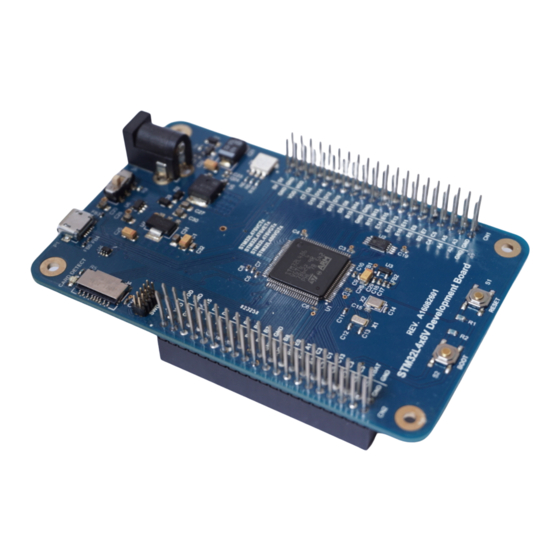
ST STM32L4x6 Manuals
Manuals and User Guides for ST STM32L4x6. We have 1 ST STM32L4x6 manual available for free PDF download: Reference Manual
ST STM32L4x6 Reference Manual (1693 pages)
Brand: ST
|
Category: Microcontrollers
|
Size: 31 MB
Table of Contents
-
-
-
Bit Banding71
-
-
-
-
Introduction78
-
FLASH Interrupts105
-
FLASH Registers106
-
-
Firewall (FW)
121-
Introduction121
-
-
Firewall States126
-
-
-
Power Supplies133
-
Low-Power Modes141
-
Run Mode147
-
Low Power Modes149
-
Sleep Mode150
-
Table 22. Sleep150
-
Stop 0 Mode151
-
Stop 1 Mode153
-
Stop 2 Mode154
-
Standby Mode157
-
Shutdown Mode159
-
PWR Registers161
-
Reset179
-
-
-
Clocks181
-
HSE Clock185
-
HSI16 Clock186
-
MSI Clock187
-
LSE Clock188
-
LSI Clock189
-
ADC Clock191
-
Low-Power Modes195
-
Introduction254
-
GPIO Registers264
-
-
Introduction286
-
-
Introduction295
-
-
DMA Channels298
-
Error Management301
-
-
DMA Registers307
-
Introduction324
-
-
-
AHB Interface345
-
-
Introduction400
-
-
Introduction426
-
-
-
Clocks431
-
-
Trigger Occurs458
-
Data Management463
-
Oversampler478
-
Dual ADC Modes483
-
-
-
Introduction541
-
-
DAC Conversion544
-
Noise Generation546
-
DAC Registers559
-
-
-
COMP Registers584
-
Introduction589
-
OPAMP Modes591
-
Calibration594
-
OPAMP Registers597
-
-
Integrator Unit620
-
-
-
-
-
Common Driver662
-
Segment Driver665
-
Flowchart678
-
LCD Registers681
-
-
-
Reset and Clocks694
-
Acquisition Mode698
-
TSC Registers700
-
Introduction710
-
Operation711
-
RNG Registers712
-
-
Data Type729
-
Operating Modes731
-
Error Flags735
-
AES Interrupts737
-
AES Registers738
-
Counter Modes756
-
Clock Selection771
-
-
PWM Mode781
-
Debug Mode811
-
-
Counter Modes861
-
Is Not Used867
-
Clock Selection871
-
PWM Mode881
-
DMA Burst Mode900
-
Debug Mode901
-
-
Counter Modes936
-
Preloaded)939
-
Clock Selection941
-
PWM Mode949
-
Debug Mode964
-
TIM15 Registers965
-
-
Counting Mode1013
-
Preloaded)1015
-
Preloaded)1016
-
UIF Bit Remapping1016
-
Debug Mode1017
-
Introduction1023
-
-
Prescaler1026
-
Operating Mode1027
-
Timeout Function1028
-
Waveform Generation1029
-
Register Update1030
-
Counter Mode1031
-
LPTIM Interrupts1034
-
LPTIM Registers1035
-
-
-
Introduction1047
-
Window Option1048
-
Low-Power Freeze1049
-
-
IWDG Registers1050
-
-
-
RTC Main Features1064
-
-
Clock and Prescalers1067
-
Programmable Alarms1069
-
Reading the Calendar1071
-
Resetting the RTC1072
-
RTC Synchronization1073
-
Time-Stamp Function1076
-
Tamper Detection1077
-
RTC Interrupts1080
-
RTC Registers1081
-
Introduction1107
-
I2C Initialization1112
-
Software Reset1116
-
Data Transfer1117
-
I2C Slave Mode1119
-
I2C Master Mode1128
-
(Max T IDLE = 50 Μs)1147
-
Smbus Slave Mode1147
-
DMA Requests1157
-
Debug Mode1158
-
I2C Registers1160
-
-
Transmitter (USART)
1178-
USART Implementation1180
-
USART Transmitter1185
-
USART Receiver1187
-
USART Parity Control1201
-
USART Registers1222
-
Transmitter (LPUART)
1245-
LPUART Main Features1246
-
-
LPUART Transmitter1251
-
LPUART Receiver1253
-
LPUART Interrupts1266
-
LPUART Registers1268
-
Introduction1283
-
-
Configuration of SPI1292
-
SPI Status Flags1303
-
SPI Error Flags1304
-
NSS Pulse Mode1305
-
CRC Calculation1306
-
SPI Interrupts1308
-
SPI Registers1309
-
SAI Main Features1319
-
-
Main SAI Modes1321
-
Audio Data Size1323
-
Slot Configuration1326
-
SAI Clock Generator1328
-
Internal Fifos1330
-
SPDIF Output1334
-
Specific Features1336
-
Error Flags1341
-
Disabling the SAI1344
-
-
SAI Interrupts1345
-
SAI Registers1346
-
Introduction1363
-
SWPMI Main Features1364
-
-
Reception Procedure1372
-
Error Management1377
-
Loopback Mode1379
-
SWPMI Registers1381
-
SDMMC Main Features1393
-
-
SDMMC APB2 Interface1408
-
-
Block Write1411
-
Block Read1412
-
Card Status Register1418
-
SD Status Register1420
-
Table 229. SD Status1421
-
SD I/O Mode1425
-
Table 241. Lock Card1428
-
Response Formats1429
-
R3 (OCR Register)1431
-
SDMMC Registers1435
-
Introduction1451
-
Test Mode1455
-
-
Identifier Filtering1460
-
Message Storage1464
-
Error Management1466
-
Bxcan Interrupts1469
-
CAN Registers1470
-
CAN Filter Registers1487
-
Introduction1495
-
Host-Mode Features1496
-
USB Host1505
-
Power Options1511
-
OTG_FS Interrupts1517
-
OTG_FS Registers1522
-
Host-Mode Registers1551
-
Core Initialization1594
-
Host Initialization1595
-
SW Debug Port1655
-
-
Advertisement
Advertisement
